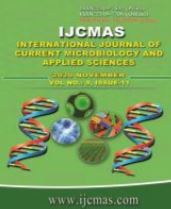


 National Academy of Agricultural Sciences (NAAS)
National Academy of Agricultural Sciences (NAAS)

|
PRINT ISSN : 2319-7692
Online ISSN : 2319-7706 Issues : 12 per year Publisher : Excellent Publishers Email : editorijcmas@gmail.com / submit@ijcmas.com Editor-in-chief: Dr.M.Prakash Index Copernicus ICV 2018: 95.39 NAAS RATING 2020: 5.38 |
Present investigation was carried out in Kharif 2019 at Experimental Area, Department of Plant Breeding and Genetics, Bihar Agricultural University, Sabour, Bhagalpur with seven parental inbred lines and their twenty one F1’s generated through half diallel matting scheme during Rabi, 2018-19. The experiment was performed in randomized block design with three replications. Analysis of variance for diallel analysis (method II model I) revealed the mean squares due to genotypes, parents, hybrids and parent vs. hybrids were highly significant for all the fourteen quantitative characters under study. Analysis of variance for combining ability revealed the mean squares due to GCA and SCA were highly significant for all the characters study. The parents, P1 and P7 had significant to highly significant positive GCA effects for grain yield per plant and its attributes indicated these two parents were good general combiners for this trait. The cross combinations, P1 x P2, P1 x P4, P1 x P5, P2 x P3, P2 x P4, P2 x P5, P2 x P6, P3 x P4, P3 x P5, P3 x P6, P3 x P7, P4 x P5, P5 x P6, and P6 x P7 had significant to highly significant SCA effects for grain yield per plant. The estimates of variance ratios of gca and sca were smaller than unity for all the characters study. The estimates of standard heterosis over the best check, DMRH-1308 for grain yield per plant revealed the top five cross combinations, namely P2 x P3, P6 x P7, P1 x P4, P3 x P4 and P3 x P6 exhibited highly significant positive standard heterosis. On the basis of standard heterosis, high SCA effects and high GCA effects for at least female parent for grain yield per plant and its attributes the hybrids, namely, P1 x P2, P1 x P4 and P1 x P5 were considered as promising experimental hybrids and may be exploited commercially after critical evaluation for their superior and stable performance over environments.
 |
 |
 |
 |
 |